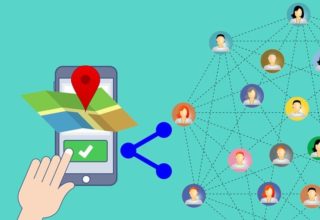
Mobility and transport affect everyone. From daily commuting to work, visiting family and friends, tourism, to the proper functioning of global supply chains for the goods in our shops and for our industrial production, mobility is an enabler of our economic and social life. Whilst mobility brings many benefits for its users, it is not without costs for our society. These include greenhouse gas emissions, air, noise and water pollution, but also accidents and road crashes, congestion, and biodiversity loss – all of which affect our health and wellbeing.
How AI Can Change The Transportation Sector
The transportation sector has to do with the transfer of passengers and goods from one location to another. Over the last decades, AI has changed the transportation industry dramatically.
Applying AI technologies, the safety of passengers improved, the accident rates decreased, CO2 emissions are far less, the traffic jam is less. On top of these important improvements, the total cost of transportation has been minimized, and within a more environmental friendly way.
Autonomous vehicles
Self-driving cars are nowadays a reality. It is known that self-governing taxis are already on the streets of the Japanese capital city.
On the same track, logistic companies in the US are starting to own self-driving trucks to exploit the multiple advantages that they have to offer. Based on recent studies, 65% of global commodities are being carried by trucks. By using self-driven trucks, the total cost can be reduced by 45%. These are numbers that the industry cannot neglect.
Traffic management
A transportation issue that people all over the world are facing every day is traffic jam. Artificial Intelligence technologies can offer solutions to this problem as well.
Micro cameras and sensors placed on various spots of the streets can gather traffic information in bulk. This valuable traffic data then can be sent to the cloud whereas can be analyzed in order to evaluate the traffic patterns. Big data management and analytics will provide corrective actions that can be applied by traffic lights, autonomous cars, police etc.
Predictions on a daily basis
Flight delays were always a big issue for air carriers to solve. Bear in mind that only in the US, the cost from flight delays is estimated at about $40 billion. This estimation comes from Berkeley, University of US California.
Weather conditions or faults in technical equipment can cause a delay for air flights. Analyzing big data from the past, can reveal a pattern and predict these situations in the future.
Drone taxis
Recently there was a demonstration of drone taxis in China. At this event, 17 passengers were the first that had the experience of smart air transportation. This event shows us what we can expect from the near future when it comes to AI applications.
How AI is Shaping the Mobility Scene
Technologies in mobility are driving users to a more accessible and friendly means of transportation. Smart technology in mobility leads to economy improvement of cities, better procedures of logistics. It also makes the labour market more accessible and brings new opportunities for corporations.
Self-driving vehicles and aerial delivery of commodities via drones are only some of the technologies that will dominate the future of the mobility sector.
Actually, things must change in the transportation of commodities and people since the current situation creates increasing rates of traffic congestion, makes more harm to the environment, includes more noise and there are significant limitations in space within the urban areas.
Driver monitoring
This is the technology applied to constantly monitor the physical situation of a driver. Driver monitoring identifies the driver and controls the level of alertness. If the driver gets distracted, then the system alerts him or her.
Driver monitoring relies on Artificial Intelligence algorithms that check the eyes, the position of the head, and also other signs that indicate the level of alertness.
Self-learning systems and computerized vision are the core elements of an autonomous vehicle. These elements do all the processing and interpret all the data coming from micro cameras and sensors.
It is obvious that a system that collects, analyses, and constantly adapting the information from the external environment is a prerequisite.
Maritime
The maritime industry is one of the pillars of the global economy, and one in which Greece has a competitive advantage, with the Greek-owned merchant fleet size ranking first in the world, accounting for 7.6% of the world’s fleet in terms of ship numbers. Although the maritime industry is considered a conservative one, the current wave of massive digitization is quickly disrupting the entire sector. An innovation race is on in the maritime industry, the outcomes of which may be greatly beneficial both for the economy and the environment, laying the foundation for sustainable growth in the years to come.
A multitude of both on-vessel and ground sensors are producing massive information flows on a daily basis. The variety of such information ranges from signals transmitting vessel identification information, characteristics, and destination; on-board sensor signals transmitting position and speed, while potentially reporting on the vessel’s and cargo status via the Internet of Things technology which is quickly entering the picture; Environmental monitoring signals emitted from various types of floating and submerged devices and sensors.
Processing and combining information from such data streams allows for real-time situational awareness in the maritime domain, i.e., the ability to perceive the surrounding environment, comprehend current situations, and project them into the future. It turns, this can have a profound impact in the maritime industry, via promoting safety, detecting illegal activity, and reducing costs, environmental, or otherwise. Additionally, making sense of the complex and dynamic network of ships and their cargo constantly in motion across the world’s oceans, via processing such information flows, can provide insights into the global supply and demand trends. Such insights may be used together with more traditional (and static) information used to document the status of the maritime industry and forecast its development (e.g. the Baltic Dry Index), thus facilitating the decision-making process of stakeholders in the maritime sector.
Taking advantage of the current industry disruption opportunity in the maritime sector requires robust and scalable information processing systems, capable of making sense of a multitude of heterogeneous data streams with sub-second latency, timely detecting and accurately forecasting critical situations/events via sophisticated models. In turn, this calls for high-quality systems combining and optimizing techniques for Complex Event Processing and Forecasting, Machine Learning, Artificial Intelligence and Distributed Computing.
Thanks to its long-standing experience in the aforementioned research fields, NSCR-D can greatly contribute to the current wave of innovation in the maritime industry. The research and development involvement of NSCR-D that started in the context of the AMINESS national project is extended through actions such as the datACRON and the INFORE (starting January 2019) EU-funded projects, while it provides open-source software for complex event recognition, forecasting and machine learning, tailored towards the needs of the maritime industry.
Relevant Market Sectors
Shipping companies
Companies providing specialized services for the maritime industry
Government and public sector
How AI is Transforming The Supply Chain and Global Logistics
AI is already here and it’s the future when it comes to handling the supply chain and logistics.
Companies nowadays exploit AI applications to plan their network and to forecast the demand. These applications benefit them in numerous areas and make them more effective.
Seeing driverless trucks on the streets 0f cities may take a while, yet the logistics sector is already exploiting high-tech driving to improve safety and enhance efficiency.
On top of that, business organizations exploit AI technologies and machine learning technologies to update their perspicacity into various sections that include logistic procedures, warehouse control, and supply chain handling.
Actions & Services
- Complex event processing and forecasting
- Maritime surveillance
- Process monitoring
- Alerting services
- Machine learning for modelling complex vessel behaviour
- Trajectory forecasting
Business Partners
- MarineTraffic: MarineTraffic is the world’s leading provider of ship tracking and maritime intelligence. Building on a base of data gathered from our network of coastal AIS-receiving stations, supplemented by satellite receivers, it applies algorithms and integrates complementary data sources to provide the shipping, trade and logistics industries with actionable insights into shipping activity.
- Danaos: Danaos manages one of the largest independently owned fleet of modern, large-size containerships. Danaos has been widely recognised for its operational performance, technological innovation, high operational standards and commitment to sustainability.







